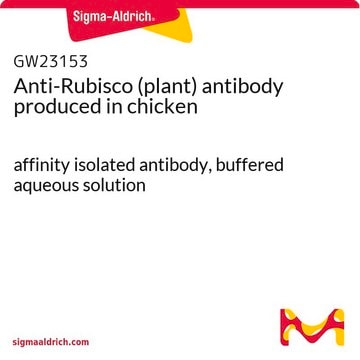R8000
D-Ribulose 1,5-Diphosphate Carboxylase from spinach
partially purified powder, 0.01-0.1 unit/mg solid
Synonym(s):
3-Phospho-D-glycerate carboxy-lyase(dimerizing), Rubisco
Sign Into View Organizational & Contract Pricing
All Photos(1)
About This Item
CAS Number:
MDL number:
UNSPSC Code:
12352204
NACRES:
NA.54
Recommended Products
biological source
spinach
form
partially purified powder
specific activity
0.01-0.1 unit/mg solid
mol wt
557 kDa
storage temp.
−20°C
General description
D-Ribulose 1,5-Diphosphate Carboxylase (RUBISCO) amounts to 50% of the total spinach leaves associated soluble protein.
Exists as a 557 kDa hexadecamer composed of eight heavy chains each with a molecular weight of approximately 56 kDa and eight light chains of molecular weight 14 kDa. Each molecule contains one magnesium ion.
pH optimum: ~7.9.
KM for CO2: ~0.45 mM.
Ribulose diphosphate becomes inhibitory at concentrations exceeding 0.7 mM. Orthophosphate and ammonium sulfate are competitive inhibitors. 3-Phosphoglycerate is a noncompetitive inhibitor.
pH optimum: ~7.9.
KM for CO2: ~0.45 mM.
Ribulose diphosphate becomes inhibitory at concentrations exceeding 0.7 mM. Orthophosphate and ammonium sulfate are competitive inhibitors. 3-Phosphoglycerate is a noncompetitive inhibitor.
Application
D-Ribulose 1,5-Diphosphate Carboxylase from spinach has been used:
- as a test protein in pepsin digestion studies
- as an innocuous or non-hazardous protein sample to test its effect on human intestinal epithelial cell lines
- in isothermal titration calorimetry (ITC), and radiolabeled binding assays with abscisic acid
Biochem/physiol Actions
D-Ribulose 1,5-Diphosphate Carboxylase (RUBISCO) depends on Rubisco activase and chaperones for activation. It participates in plant photorespiration events by catalyzing the carboxylation and oxygenation of ribulose-1,5-bisphosphate. Abscisic acid inhibits the carboxylation activity of Rubisco.
Unit Definition
One unit will convert 1.0 μmole of D-RuDP and CO2 to 2.0 μmoles of D-3-phosphoglycerate per min at pH 7.8 at 25°C.
Signal Word
Danger
Hazard Statements
Precautionary Statements
Hazard Classifications
Resp. Sens. 1
Storage Class Code
11 - Combustible Solids
WGK
WGK 1
Flash Point(F)
Not applicable
Flash Point(C)
Not applicable
Personal Protective Equipment
dust mask type N95 (US), Eyeshields, Gloves
Certificates of Analysis (COA)
Search for Certificates of Analysis (COA) by entering the products Lot/Batch Number. Lot and Batch Numbers can be found on a product’s label following the words ‘Lot’ or ‘Batch’.
Already Own This Product?
Find documentation for the products that you have recently purchased in the Document Library.
Martin A J Parry et al.
Journal of experimental botany, 64(3), 717-730 (2012-11-20)
Rubisco (ribulose-1,5-bisphosphate (RuBP) carboxylase/oxygenase) enables net carbon fixation through the carboxylation of RuBP. However, some characteristics of Rubisco make it surprisingly inefficient and compromise photosynthetic productivity. For example, Rubisco catalyses a wasteful reaction with oxygen that leads to the release
Dennis McNevin et al.
Journal of experimental botany, 57(14), 3883-3900 (2006-10-19)
The forward and reverse rate constants involved in carbamylation, activation, carboxylation, and inhibition of D-ribulose-1,5-bisphosphate carboxylase/oxygenase (RuBisCO) have been estimated by a new technique of simultaneous non-linear regression of a differential equation kinetic model to multiple experimental data. Parameters predicted
K Thomas et al.
Regulatory toxicology and pharmacology : RTP, 39(2), 87-98 (2004-03-26)
Rationale. Evaluation of the potential allergenicity of proteins derived from genetically modified foods has involved a weight of evidence approach that incorporates an evaluation of protein digestibility in pepsin. Currently, there is no standardized protocol to assess the digestibility of
Benjamin D Rae et al.
Microbiology and molecular biology reviews : MMBR, 77(3), 357-379 (2013-09-06)
Cyanobacteria are the globally dominant photoautotrophic lineage. Their success is dependent on a set of adaptations collectively termed the CO2-concentrating mechanism (CCM). The purpose of the CCM is to support effective CO2 fixation by enhancing the chemical conditions in the
Guillaume Tcherkez
Plant, cell & environment, 36(9), 1586-1596 (2013-01-12)
Although ribulose-1,5-bisphosphate carboxylase/oxygenase (Rubisco) was discovered nearly 60 years ago, the associated chemical mechanism of the reaction is still incompletely understood. The catalytic cycle consists of four major steps: ribulose-1,5-bisphosphate binding, enolization, CO₂ or O₂ addition and hydration, and cleavage
Our team of scientists has experience in all areas of research including Life Science, Material Science, Chemical Synthesis, Chromatography, Analytical and many others.
Contact Technical Service







